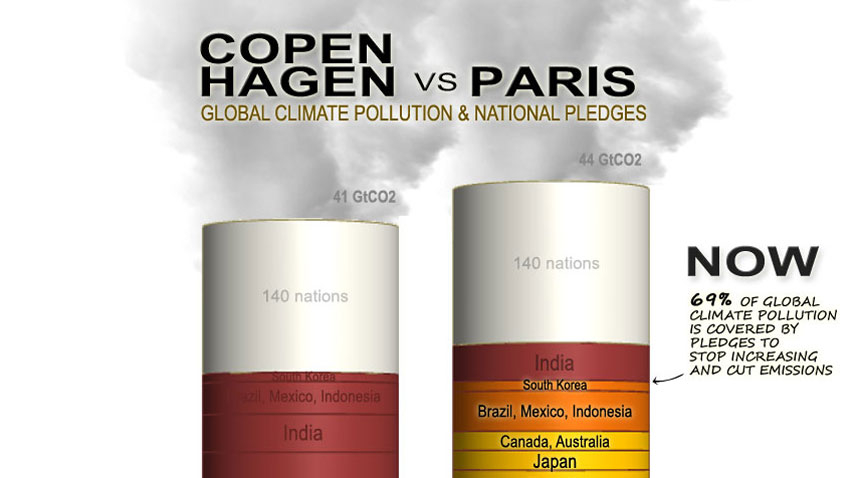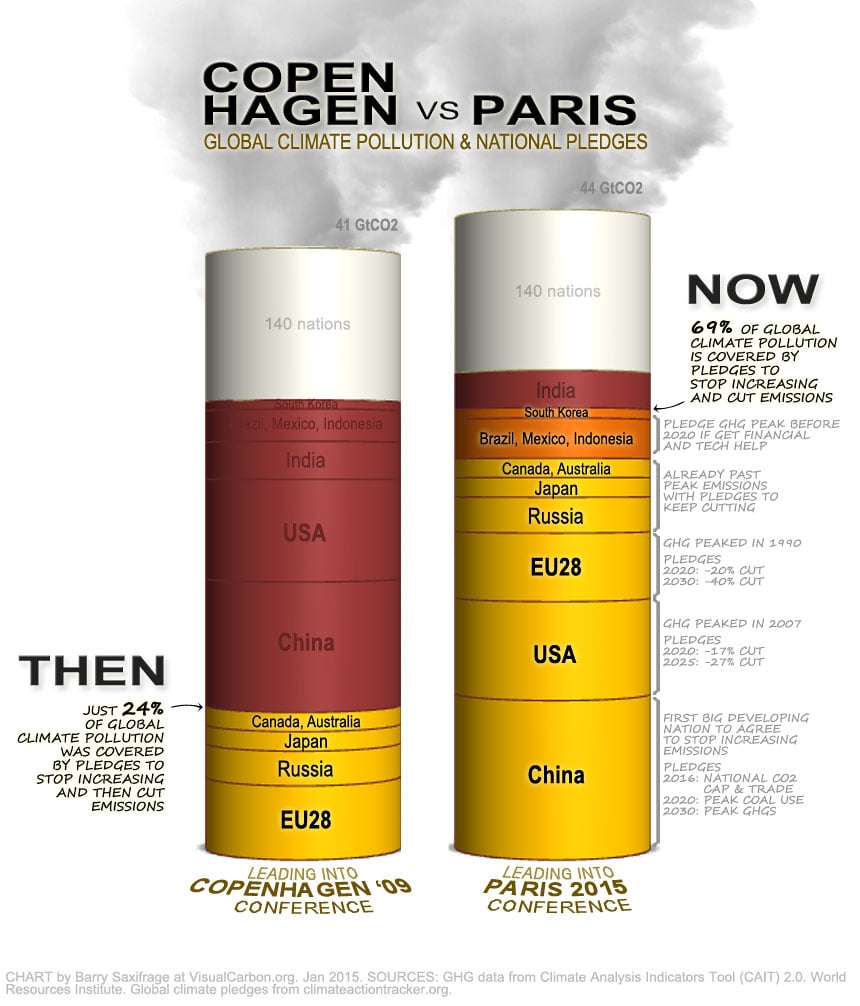Paris vs. Copenhagen: global majority now committed to climate action

What a difference a few years can make.
Over the last few years, climate change has expanded from a mostly "environmental" threat that engaged a small minority of the world economies, into a wide-ranging environmental, economic, moral and military threat that now has a sizable majority of the world's economic powers committed. Here's a look at the new landscape.
Spotlight: Paris 2015 vs. Copenhagen 2009
As my infographic below illustrates, international commitment to solving the climate crisis has grown dramatically since the last major climate conference in 2009.

Then: small minority at Copenhagen'09
Six years ago, as the world headed into the Copenhagen 2009 climate conference, only a quarter of the world's greenhouse-gas emissions were covered by commitments to peak and then lower emissions.1 Just one of the three major economies, the European Union (EU), had made commitments.
Discussions hadn't even begun on carbon budgets, carbon bubbles, stranded assets or divestment. Pipelines got rubber-stamped.
Major religions, anti-poverty and human rights groups were not strongly engaged. Global finance was mostly on the sidelines.
Now: global majority for Paris '15
Today, heading into the next major climate conference, Paris 2015, more than two-thirds of the world's emissions are covered by public commitments to peak and lower emissions.2 Over two-thirds of the global economy is signed up.
For the first time, many major developing nations are committed.
Joining these major nation-states is a rapidly growing list of global financial, religious and civil society groups. Even the US military is increasingly engaged.
While the most critical requirement – a reduction in global climate pollution – hasn't happened yet, the underlying commitment to find a solution has grown dramatically. The global trend-line is towards ever greater engagement and commitment.
Climate pledges and progress by the Big 3: USA, China and EU
Probably the biggest tipping point so far in the climate fight is the recent emergence of all three of the world's great economies – USA, China and EU – as strong supporters of climate action. These "Big Three" alone represent half the world's climate pollution and half the world's economic power.3
In a game-changing new alliance, Chinese President Xi Jinping and US President Barack Obama stood together last November to make a "U.S.-China Joint Announcement" on the need to act on the climate threat.
Here are some of the significant climate actions by Big Three in the last few years:
USA climate action
Since Copenhagen, the USA has been leading the world in total climate pollution reductions. American emissions are down 500 million tonnes of CO2 (MtCO2) a year since the start of 2009.4
Both Canada and USA pledged in the Copenhagen Accord to cut emissions 17 per cent by 2020.5 America is on track. Canada isn't. America says it has a plan to get there: "The President’s Climate Action Plan."6
Canada, by contrast, is falling far behind the USA. Canada says all its current climate plans won't be enough to prevent dramatic failure.7
Recently, the USA doubled its climate commitment. America's new climate commitment for 2025 is twice as aggressive per year as their Copenhagen pledge. Their promised rate of emissions cuts has doubled to two per cent per year.8
"No challenge poses a greater threat to future generations than climate change… The Pentagon says that climate change poses immediate risks to our national security. We should act like it," U.S. President Barack Obama said in his 2015 State of the Union9 address.
European Union climate action
The EU28 says it has already met its Kyoto promise to cut emissions by 20 per cent from 1990 levels.
Since the start of 2009, their annual emissions have fallen by 355 MtCO2.
Like the USA, the EU28 also recently doubled down on their climate commitment. They now promise to cut emissions by 40 per cent by 2030. That reduction rate would match the USA's newly pledged rate of reductions of two per cent per year.
China climate action
About half of the all the increases in climate pollution since 2009 have come from China. Almost all of this has come from their ever increasing amounts of coal burning. But that seems to be shifting dramatically in the last couple years.
China's coal burning declined last year for the first time this century. The nation just pledged peak coal by 2020, but many analysts think it may have already peaked two years ago.
Just a few months ago, China became the first developing nation to unilaterally and unconditionally agree to peak emissions by a given year. They promised to peak by 2030 with "best efforts to peak early." Again, many analysts think that China is poised to peak well before 2030, which is why they made the unusual promise to try to be "early."
Developing nations joining the climate fight
Equally transformative are the recent decisions by several major developing economies to publicly commit to peaking and then reducing emissions.
This has been a major stumbling block for decades.
Brazil, Mexico, Indonesia and South Korea all have pledged to peak emissions by 2020 if given the financial and technical help to achieve this.10
The nation with the largest potential to push global emissions higher at this point is India. With a population the size of China's but much poorer and less developed, much depends on whether India turns to coal or renewables to lift its citizens out of poverty. There are signs pointing both ways. On the hopeful side, US President Obama recently visited India and climate change was high on the agenda. Afterwards, US Secretary of State John Kerry said the two nations are "committed to working closely together to achieve a successful global agreement in Paris … India has joined in that challenge." And Indian Prime Minister Narendra Modi gave a speech where he said bluntly:
"The world have to discuss climate change on the same level as they do discuss terrorism. It poses a serious threat as terrorism."
Up next: beyond nation states...
The shift in commitment by national governments is just one part of the story. My next article in this series will show how the post-Copenhagen 2009 surge in global climate commitment reaches far beyond national governments to include major spiritual, human rights, military, First Nations, environmental, anti-poverty and financial groups.
Stay tuned...
1 Country emissions data from CAIT (cait2.wri.org). THE BIG 12: Eleven major emitting nations plus the EU28 account for 74 per cent of global GHG. The remaining 26 per cent of global GHG come from the remaining 140+ nations. These BIG 12 are shown in the chart. In 2008, only the EU28, Russia, Japan, Canada and Australia had formal commitments to peak and lower emissions. These 5 produced 24 per cent of global GHG. Now in 2014, all of the BIG 12 except India have formal commitments to peak and then lower emissions. These 11 emit 69 per cent of global GHG.
2 See endnote immediately above.
3 Emissions data from CAIT. GDP data from world bank.
4 US EIA data for CO2 changes from start of 2009 to 2012, which is the latest year that data is available for.
5 First Biennial Report of the United States of America.
6 First Biennial Report of the United States of America.
7 Projected emissions through 2020 from Environment Canada's Emissions Trends 2014 report .Projected emissions from 2020-2030 from federal government's National Round Table on the Environment and the Economy report "Reality Check: The State of Climate Progress in Canada". Quote: " emissions continue to grow between 2020 and 2030 even under all existing and proposed policies"
8 "The new U.S. goal will double the pace of carbon pollution reduction from 1.2 percent per year on average during the 2005-2020 period to 2.3-2.8 percent per year on average between 2020 and 2025."
9 US President Barack Obama in 2015 State of the Union address.
10 Brazil, Mexico, Indonesia and South Korea all have pledged to peak emissions by 2020 if given financial and technical help.



Comments